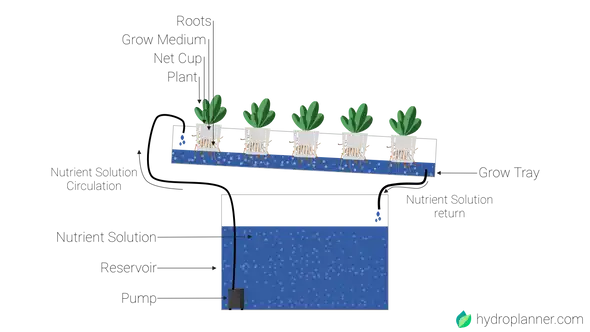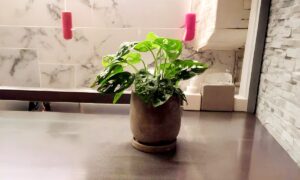
Hydroponic systems are a great way to grow plants without soil, and there are many beginner-friendly options available. Here are some examples:
In this article
Pathonor Hydroponic System
The Pathonor Hydroponic System is a popular choice for indoor gardening enthusiasts who want to grow plants without soil. It is easy to set up and maintain, making it suitable for beginners. The system is self-watering and uses a DWC hydroponic system, which is a simple and effective way to grow plants hydroponically.
This system is made of food-grade plastic and has spots for eleven different plants. It is easy to set up and comes with clear instructions.
Deep Water Culture (DWC) System
A Deep Water Culture (DWC) hydroponic system is a type of hydroponic growing method that sustains plant roots in a well-oxygenated solution full of nutrients and water 24/7. In this system, the roots are suspended in a deep water solution, unlike other hydroponic techniques like the Ebb and Flow, Aeroponics, and Drip System, in which plants are only watered on a constant basis. DWC hydroponics is the most simple hydroponic system for new and experienced indoor growers alike.
This system is straightforward to set up and doesn’t require a lot of equipment. It is also very space-efficient and can be easily scaled to any size. However, smaller setups are prone to fluctuations in water temperature and pH, and if the roots of the plants are not properly aerated, they will drown.
DIY Hydroponic System
If you’re on a budget, you can build your own hydroponic system using materials you may already have at home. Instructables has a step-by-step guide to building a simple Deep Water Culture (DWC) hydroponic system.
Nutrient Film Technique (NFT)
The Nutrient Film Technique (NFT) is a hydroponic technique that involves growing plants in a shallow stream of water containing all the dissolved nutrients necessary for their growth12. In this system, the water flow is circulated through growth tanks, and the plants absorb the nutrients through their roots, which are suspended in the air.

This system uses a continuous flow of nutrient solution to grow plants in a shallow channel. It is easy to set up and maintain, but it can be more expensive than other systems.
Ebb and Flow (Flood and Drain)
The Ebb and Flow system, also recognized as Flood and Drain, stands as one of the most prevalent and versatile hydroponic setups. In this method, plants find their home in a spacious grow bed, typically filled with a grow medium like rockwool or perlite. When it’s time to nourish the plants, the grow bed is flooded with a nutrient-rich solution, stopping just a couple of inches below the grow medium’s surface to prevent overflow.
A timer-equipped water pump takes charge, ensuring the grow bed is adequately flooded. After the designated time, the pump shuts off, and the nutrient solution begins its journey back into the pump for reuse. This cyclic process maintains an ideal nutrient balance for plant growth. While this system can accommodate a wide variety of plants, including root vegetables like carrots and radishes, it’s wise to avoid particularly large plants, as they can occupy a significant amount of space within the grow bed.
Aeroponics
Aeroponics takes hydroponics to the next level by suspending the nutrient solution in the air. In this system, plant roots are intermittently misted with the nutrient solution, creating a highly oxygenated environment that promotes rapid growth. However, it’s worth noting that aeroponics demands a higher level of expertise and maintenance compared to other hydroponic systems.
Despite its complexity, aeroponics offers impressive advantages, including accelerated growth rates and higher yields. It’s a versatile method suitable for growing a wide array of plants, from delicate leafy greens and herbs to some fruiting plants. The misting process ensures that plant roots have direct access to the essential nutrients they need for robust growth, making it a favorite among experienced hydroponic enthusiasts.
Drip System (Fertigation System)
The Drip System, also referred to as a fertigation system, is one of the most user-friendly hydroponic systems, making it an excellent choice for both beginners and experienced growers. What sets this system apart is its adaptability, as it can be easily customized to suit the needs of different plants.
In a Drip System, a nutrient solution is pumped into a network of tubes that deliver the solution directly to the base of each plant. At the ends of these tubes, you’ll find drip emitters that regulate the release of the nutrient solution, ensuring precise and efficient delivery to the plant roots. Commercial hydroponic setups often favor this system due to its effectiveness and ease of use.
Like other hydroponic methods, the Drip System accommodates a variety of plants, including leafy greens, herbs, and some fruiting plants. Its flexibility and consistent nutrient supply make it a top choice for growers looking for a straightforward yet highly effective way to cultivate a diverse range of crops.
When choosing a hydroponic system, consider factors such as cost, space, and ease of use. It’s also important to choose a system that is appropriate for the types of plants you want to grow. With the right system and a little bit of practice, you can enjoy fresh, homegrown produce all year round.







